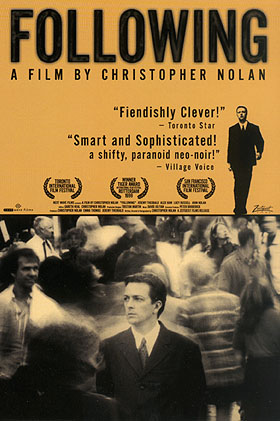 Now widely heralded as reviving, the once clinically dead Batman franchise with two critically and commercially successful films, director Christopher Nolan started out on a much smaller scale. His feature debut, Following, was shot on a shoestring budget and is an early example of the talent that has brought him to where he currently sits on the Hollywood totem pole. Filmed in London, Following tells the story of an unnamed loner (Jeremy Theobald), who one day decides to simply follow people he sees on the street under the pretext of research for his writing. This is nothing but a self-justifying excuse that gets thrown away the instant he runs into Cobb (Alex Haw), a more evolved version of himself, who burgles apartments for the rush. From then on the picture, which wasn’t all that upbeat to begin with, starts to take a decidedly more sinister tone. The film then introduces a mysterious woman (Lucy Russell), who adds a couple of wrinkles to the plot.
Now widely heralded as reviving, the once clinically dead Batman franchise with two critically and commercially successful films, director Christopher Nolan started out on a much smaller scale. His feature debut, Following, was shot on a shoestring budget and is an early example of the talent that has brought him to where he currently sits on the Hollywood totem pole. Filmed in London, Following tells the story of an unnamed loner (Jeremy Theobald), who one day decides to simply follow people he sees on the street under the pretext of research for his writing. This is nothing but a self-justifying excuse that gets thrown away the instant he runs into Cobb (Alex Haw), a more evolved version of himself, who burgles apartments for the rush. From then on the picture, which wasn’t all that upbeat to begin with, starts to take a decidedly more sinister tone. The film then introduces a mysterious woman (Lucy Russell), who adds a couple of wrinkles to the plot.
Following deals with a lot of morally murky themes, particularly voyeurism, as the protagonist and Cobb view their burglary as a way to learn about the people they are stealing from. They rifle through strangers’ items, peering into their lives and inferring some truths about them. For Cobb, the money is besides the point, as he takes a perverse pleasure in interfering with the lives of others. This is fitting because Nolan originally came up with the idea for Following after his home had been burgled and wondered what the thieves thought as they went through his stuff.
As the film progresses and more of the plot reveals itself, similarities to Hitchcock emerge from the setup to some of the later twists, as well as the main female character being a blonde, which the master of suspense was quite fond of having in his pictures. A complication that sets this sparse tale apart from that influence is the fact that the story is told out of order, something Nolan would repeat more aggressively in his next picture Memento. Similarly to that movie, there is a sprinkling of narration that gives Following the air of a confessional. In addition, the spare score comes alive during several scenes, ratcheting the tension when needed.
As Following was shot in grainy black-and-white, we, as an audience, are constantly reminded of the cheap production values of the film, although it does reinforce the unsavory feeling that runs as an undercurrent to most of Following. It should be noted, however, that this film was made with a budget of just $6000, requiring a lot of favors from friends and family. In fact, though only just slightly more than an hour in length, filming took over a year due to the fact that cast and crew had full time jobs, so Nolan was only able to film for 15 minutes each Saturday.
Following is more than anything a showcase of how an ambitious filmmaker was able to handle serious limitations in budget and resources in order to turn out a unique story. As the film is concerned, its exploration of voyeurism is timely in the world where social networking allows us to keep an eye on people without them knowing so and asks whether that’s a good thing.

Leave a Reply